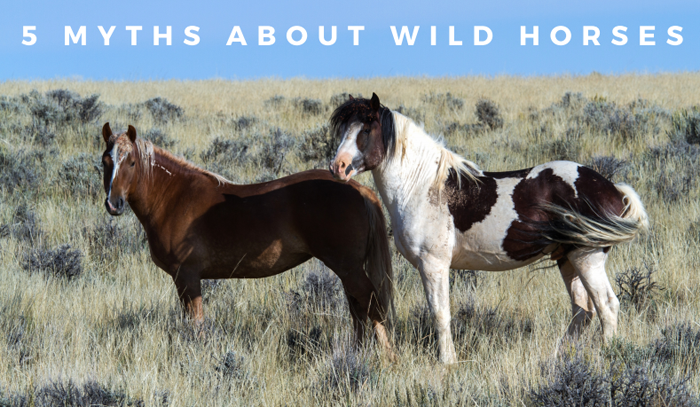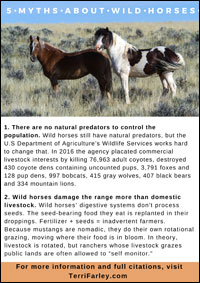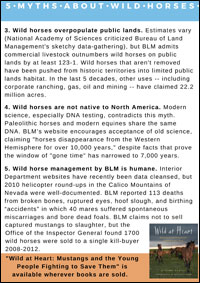
1. There are no natural predators to control the
population.
Wild horses still have natural predators, but the
U.S Department of Agriculture's Wildlife Services works hard
to change that. In 2016 the agency placated commercial
livestock interests by killing 76,963 adult coyotes, destroyed
430 coyote dens containing uncounted pups, 3,791 foxes and
128 pup dens, 997 bobcats, 415 gray wolves, 407 black bears
and 334 mountain lions.
2. Wild horses damage the range more than domestic
livestock.
Wild horses' digestive systems don't process
seeds. The seed-bearing food they eat is replanted in their
droppings. Fertilizer + seeds = inadvertent farmers.
Because mustangs are nomadic, they do their own rotational
grazing, moving where their food is in bloom. In theory,
livestock is rotated, but ranchers whose livestock grazes
public lands are often allowed to "self monitor."
3. Wild horses overpopulate public lands.
Estimates vary
(National Academy of Sciences criticized Bureau of Land
Management's sketchy data-gathering), but BLM admits
commercial livestock outnumbers wild horses on public
lands by at least 123-1. Wild horses that aren't removed have
been pushed from historic territories into limited public
lands habitat. In the last 5 decades, other uses -- including
corporate ranching, gas, oil and mining -- have claimed 22.2
million acres.
4. Wild horses are not native to North America.
Modern
science, especially DNA testing, contradicts this myth.
Paleolithic horses and modern equines share the same
DNA. BLM's website encourages acceptance of old science,
claiming "horses disappearance from the Western
Hemisphere for over 10,000 years," despite facts that prove
the window of "gone time" has narrowed to 7,000 years.
5. Wild horse management by BLM is humane.
Interior
Department websites have recently been data cleansed, but
2010 helicopter round-ups in the Calico Mountains of
Nevada were well-documented. BLM reported 113 deaths
from broken bones, ruptured eyes, hoof slough, and birthing
"accidents" in which 40 mares suffered spontaneous
miscarriages and bore dead foals. BLM claims not to sell
captured mustangs to slaughter, but the
Office of the Inspector General found 1700
wild horses were sold to a single kill-buyer
2008-2012.
Click on the images below to download the "Wild Horse Myths" handout PDF.
Wild Horse Myths - Fact Checker
- Explore U.S. Department of Agriculture's Wildlife Services (Animal and Plant Health Inspection Service)
For more basic information: https://en.wikipedia.org/wiki/Animal_and_Plant_Health_Inspection_Service actions can be found
Recent map of USDA Wildlife Services exterminations - Compare equines' digestive system with that of commercial livestock in
research by Center for Biological Diversity
and Nature Conservancy
Kansas State University Library - National Academy of Sciences evaluation of Bureau of Land Management Wild Horse and Burro program
Note: NAS was prohibited from considering the impact of wildlife and restricted to the use of BLM statistics
BLM's response to the above study - Dr. Beth Shapiro of U.C. Santa Cruz, Dr. Ross MacPhee of American Museum of Natural History, and many other paleontologists support the native status of equines "Can We Please Stop Calling Wild Horses Invasive?"
- Most death records for past round-ups have been removed from BLM website Department of the Interior Investigative Report
Home |
Books |
The Author |
Connect
Events |
Education |
Press |
Wild Horses
© Terri Farley


